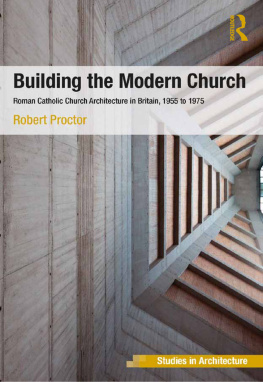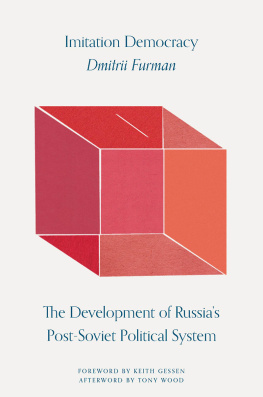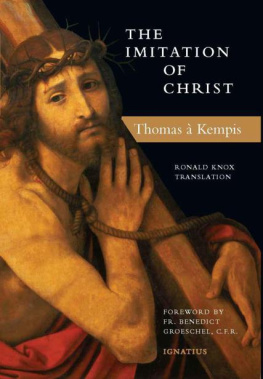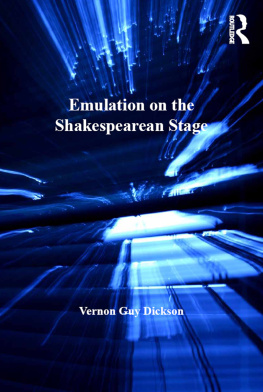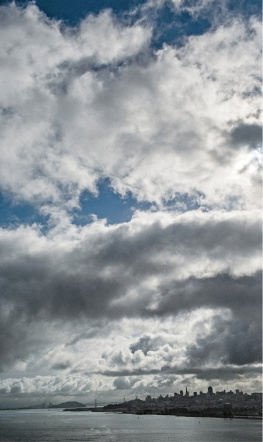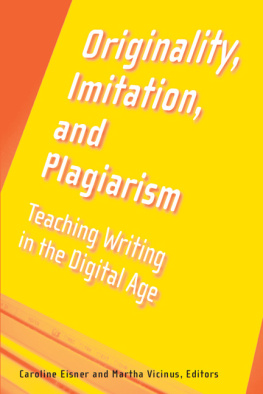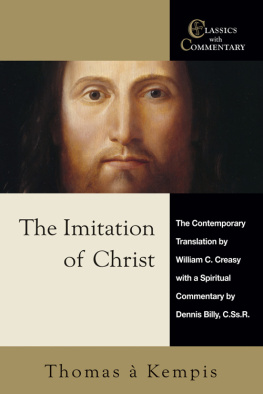BUILDING THE MODERN CHURCH
Ashgate Studies in Architecture Series
SERIES EDITOR: EAMONN CANNIFFE, MANCHESTER SCHOOL OF ARCHITECTURE, MANCHESTER METROPOLITAN UNIVERSITY, UK
The discipline of Architecture is undergoing subtle transformation as design awareness permeates our visually dominated culture. Technological change, the search for sustainability and debates around the value of place and meaning of the architectural gesture are aspects which will affect the cities we inhabit. This series seeks to address such topics, both theoretically and in practice, through the publication of high quality original research, written and visual.
Other titles in this series
The Challenge of Emulation in Art and Architecture
Between Imitation and Invention
David Mayernik
ISBN 978 1 4094 5767 1
Building Transatlantic Italy
Architectural Dialogues with Postwar America
Paolo Scrivano
ISBN 978 1 4724 1483 0
The Architectural Capriccio
Memory, Fantasy and Invention
Edited by Lucien Steil
ISBN 978 1 4094 3191 6
Forthcoming titles in this series
The Architecture of Luxury
Annette Condello
ISBN 978 1 4094 3321 7
Shoah Presence: Architectural Representations of the Holocaust
Eran Neuman
ISBN 978 1 4094 2923 4
Reconstructing Italy
The Ina-Casa Neighborhoods of the Postwar Era
Stephanie Zeier Pilat
ISBN 978 1 4094 6580 5
Building the Modern Church
Roman Catholic Church Architecture in Britain, 1955 to 1975
Robert Proctor
Glasgow School of Art, UK

First published 2014 by Ashgate Publishing
Published 2016 by Routledge
2 Park Square, Milton Park, Abingdon, Oxon OX14 4RN
711 Third Avenue, New York, NY 10017, USA
Routledge is an imprint of the Taylor & Francis Group, an informa business
Copyright 2014 Robert Proctor
Robert Proctor has asserted his right under the Copyright, Designs and Patents Act, 1988, to be identified as the author of this work.
All rights reserved. No part of this book may be reprinted or reproduced or utilised in any form or by any electronic, mechanical, or other means, now known or hereafter invented, including photocopying and recording, or in any information storage or retrieval system, without permission in writing from the publishers.
Notice:
Product or corporate names may be trademarks or registered trademarks, and are used only for identification and explanation without intent to infringe.
British Library Cataloguing in Publication Data
A catalogue record for this book is available from the British Library.
The Library of Congress has cataloged the printed edition as follows:
Proctor, Robert, 1973 author.
Building the modern church : Roman Catholic Church architecture in Britain, 1955 to 1975 / by Robert Proctor.
pages cm. (Ashgate studies in architecture)
Includes bibliographical references and index.
ISBN 978-1-4094-4915-7 (hardback : alk. paper)
1. Church architecture Great Britain History 20th century. 2. Catholic church buildings Great Britain History 20th century. I. Title.
NA5468.P76 2014
726.50941dc23
2013043683
ISBN 9781409449157 (hbk)
ISBN 9781315570495 (ebk)
To Mariadele and Nicholas
Contents
Illustrations
The author has made every effort to contact copyright holders and would be pleased to correct any errors or omissions that are brought to his attention, in subsequent editions.
BLACK AND WHITE FIGURES
COLOUR PLATES
PLANS
All plans are by Ambrose Gillick, 201213, and depict the buildings as completed and with liturgical arrangements at the time of opening, as far as can be deduced.
Acknowledgements
Inevitably, this books production has been a collaborative endeavour, and there are many people I need to thank for their involvement in the project. Most importantly, Ambrose Gillick was a project research assistant for two years, and many of the most crucial parts of this history resulted from his work. He also created many of the illustrations and obtained permissions for many more. Much of my thinking has benefited from his work and thought on the project, and his commitment and energy spurred me on.
The project was funded from several sources. The Arts and Humanities Research Council awarded me a substantial Early-Career Research Grant for the final stages of work to complete the book. In the early stages, the Paul Mellon Centre for the Study of British Art funded several research trips through smaller grants and more recently awarded Ashgate a publication grant towards the cost of producing the book. Throughout, my employer, the Glasgow School of Art, provided funding for research and time to carry it out. I am grateful to all of them and also to those individuals who helped along the way, notably Damian Sutton, Diana Periton, Florian Urban, Ken Neil, Julie Ramage, Tim Sharpe, Andrew Saint, Gavin Stamp, Alan Powers, Judi Loach, Richard Brook, Kathleen James-Chakraborty, Livia Hurley, Libby Horner, Christopher Marsden, Elaine Martini and Paul Walker. Thanks are also due to those who have given opportunities to present and publish work in progress on the project, helping to develop the ideas in this book, including Judi Loach, Raymond Quek, Monica Penick, Vladimir Kuli, Timothy Parker, Andrew Crompton, Trevor Kilgore, Claire OMahony, Jan De Maeyer, Sophie Andreae, Peter Brownhill, Andrea Longhi, Carsten Hermann and Clive Fenton, as well as Valerie Rose for accepting this book for Ashgate.
Many archivists and librarians have kindly shared their material, and I have especially to thank Canon J. A. Harding, Meg Whittle, Father David Lannon, Susannah Waters, Justine Sambrook, Jonathan Makepeace, Andrew Nicoll, Caroline Cradock, Robert Finnigan, David Buri, Nancy Young, Father John Sharp, Father Nicholas Schofield, Chris Fanning, Father Paul Harrison, Father Peter Phillips, Father Stewart Foster, Patrick Pike and Alan Randall. Many parish priests and parishioners have also taken time and interest to open their churches and share their parish histories and archives sadly far too many to list or remember, but I would like in particular to thank Paul Andersson, Father Jonathan Cotton, Canon Seamus Cunnane, Monsignor James Curry, Bernard Harrison, Father Jeremy Trood, Father John McKeown, Andrzej Suchcitz, Father Dennis Touw and Sister Anthony Wilson. I am grateful to numerous architects, artists and priests and their descendants (and practices) for graciously according interviews, furnishing documentary information and allowing me to reproduce original material, in particular Alexander Duncan Bell, Patricia Brown, David Brown, Robert Brumby, Norman Dilworth, Neil Fozzard, Martin Goalen, Tim Gough, Dennis Hepworth, George Jarosz, David John, Peter Langtry-Langton, Brian Mooney, Gerald Murphy, Barbara Powell, Jonathon Prichard, Andy MacMillan, William Mitchell, Joy Mitchell, Richard OMahony, Tony Tranmer, Richard Gilbert Scott, Giles Velarde, Ronald Weeks, Desmond Williams, Iain Quayle and Austin Winkley. If there are errors of interpretation or significant omissions in my discussions of their work they are my own, and I ask their forbearance.
Introduction
On the evening of Wednesday 16 September 1959, the Roman Catholic parishioners of St Gregory the Great at South Ruislip in London gathered in their local primary school hall to hear their parish priest, Philip Dayer, describe his plans for the parish. Dayers speech provides an insight into the thoughts of a priest charged with founding a new parish. Dayer insisted that the primary aim of the fledgling parish was to build a church.
Next page
